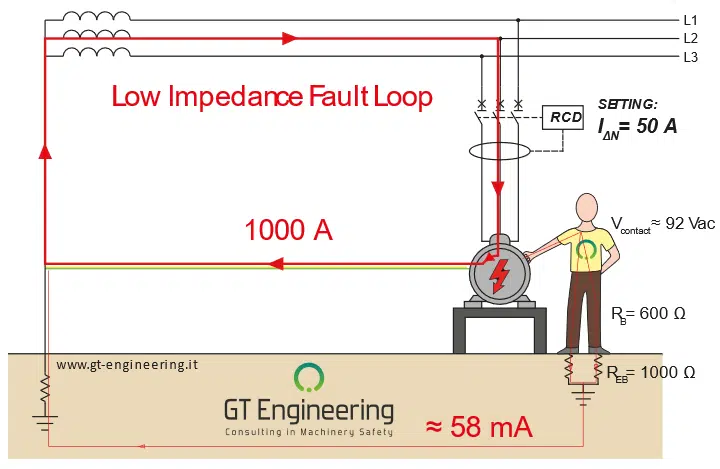Last edit: 16/03/2025
The Doubt
How to protect people from electric shocks?
Consideration 1: Direct and Indirect Contacts
An electric shock can come from a Direct Contact with a live part, that was not properly protected. Protection is achieved with the active parts properly insulated (cables) or placed inside enclosures, not accessible from the outside (IP degree of segregation).
Another situation is in case an electrical equipment, like a motor, has an internal fault and one of the stator windings comes into contact with the motor frame. In that situation the motor frame becomes energised at a dangerous voltage, due to a Ground Fault. A person touching the motor frame is subject to an electric shock. That situation is called electric shock due to an Indirect Contact and the prescription that prevents the person from getting seriously injured (death) is call “Fault Protection”.
Consideration 2: the Automatic Disconnection of Supply

The motor frame is called “Exposed Conductive Part”, Because, for one fault, can become energised.
An Exposed Conductive Part can be subject to a bolted ground fault, meaning, in our example, a ground fault with a negligeable impedance between the stator windings and the motor frame.
A way to protect the person (Fault Protection) who touches a faulty exposed conductive part is to “automatically interrupt” the energy to the faulty motor or to the electrical equipment (like A washing machine, for example).
In other words, the Automatic Disconnection of Supply is one of the Fault Protection methods. The method consists in:
- Grounding (Earthing) the neutral of the transformer (also IT systems are allowed but they will not be considered in this article)
- Creating a TN or TT grounding (earthing) system. In TN, all exposed Conductive parts are connected to the neutral, while in TT they are connected to the “dirty ground”. In TN systems a Low Impedance Fault Loop is realised (in the USA it is called an “Effective Ground-Fault Current Path” – in Canada a “low impedance circuit for mitigating ground fault currents” or also “Low Impedance Path“). In TT systems the fault loop can have a high impedance and that is the reason why it is not allowed in the USA and Canada.
- In case of a bolted fault, making sure there is a protecting device (Fuse or Circuit Breaker), having isolating characteristics (no contactors please!) that opens the fault loop. Actually, making sure that, in case of a bolted fault, the fault current is big enough to open the protecting device.
In the picture, we show a TN system where the protective device, the one opening the fault loop is a Residual Current Device (RCD).
Consideration 3: How Electrical Safety is achieved around the world
The principle of “Automatic Disconnection of Supply” is recognised and implemented all over the world. The most used grounding system is the TN-S. In USA and Canada that is called “Solidly Grounded Wye”.
How to verify that the system works in your installation? In IEC 60204-1 there are 2 tests to be performed, detailed in Chapter 18 of the standard:
- Verification of the continuity of the protective bonding circuit;
- Fault loop impedance verification.

Please consider that the verification of the proper bonding, consists in measuring the impedance of the bonding connection between the motor (exposed conductive part) and the main bonding terminal. It is not required to disconnect the PE conductor from the bonding terminal! True that in that way the measurements also include “the parallel paths”, but that is perfectly accepted by all electrical standards.
As explained in this article, only Exposed conductive parts (ECPs) must be bonded. Moreover a metal part in contact with an ECP does not become an ECP! In other terms, the rule to protect people from a ground fault is not to bond what can become energised but only what can become “Directly Energised”!
Conclusions
People are protected from electric shock when the electrical installation has Basic Protection (Insulation of live parts or Live parts placed inside IP2X or IP XXB Enclosures) and Fault Protection. The most used Fault protection method is the Automatic Disconnection of Supply.